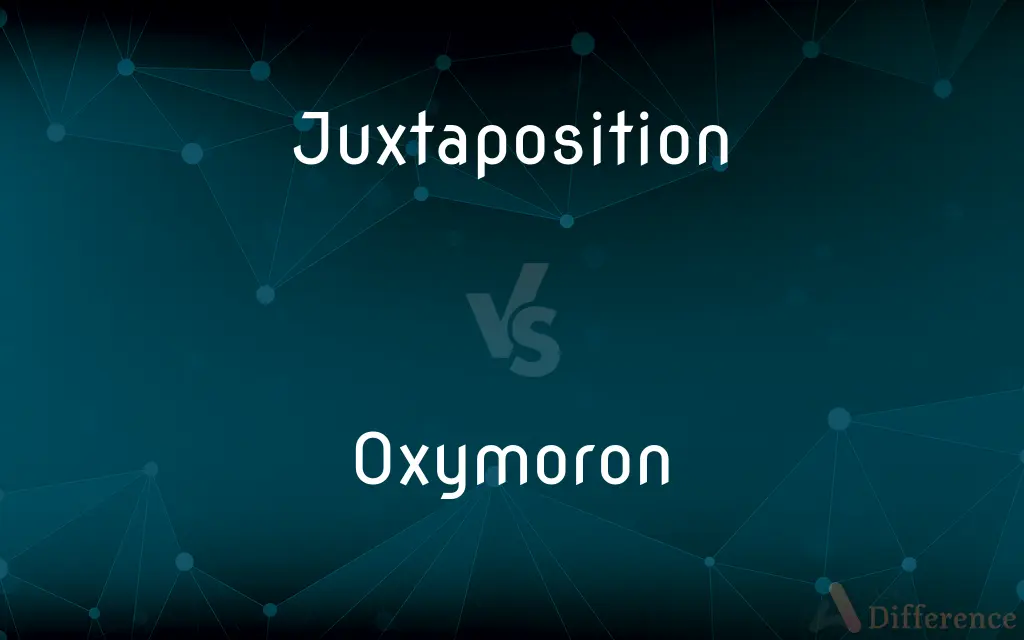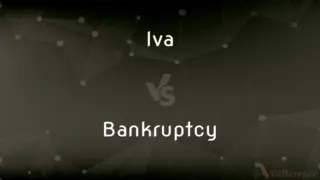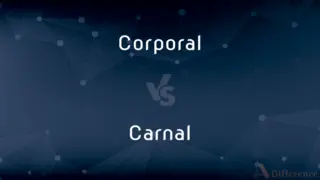Juxtaposition vs. Oxymoron — What's the Difference?
Edited by Tayyaba Rehman — By Fiza Rafique — Updated on September 20, 2023
Juxtaposition places two elements side by side for contrast, while oxymoron combines contradictory terms into a single expression, like "bitter sweet."

Difference Between Juxtaposition and Oxymoron
Table of Contents
ADVERTISEMENT
Key Differences
Juxtaposition is a literary technique that involves placing two elements or words side by side to highlight their contrasting qualities. Oxymoron, on the other hand, is a figure of speech where two seemingly opposing or contradictory elements are combined into a single phrase or term.
While juxtaposition often uses space or positioning in literature to emphasize differences or similarities, oxymoron relies on word choice to create a unique, often ironic, combination.
For instance, in literature, juxtaposition might present a wealthy king alongside a poor beggar to highlight disparities in their lives. In contrast, oxymoron might use terms like "deafening silence" to convey a profound quietness.
Both tools, juxtaposition and oxymoron, offer ways to enrich language, enhance imagery, and deepen meaning in literature and everyday speech.
Comparison Chart
Nature
Literary technique
Figure of speech
ADVERTISEMENT
Usage
Emphasizing contrast by placement
Combining contradictory terms
Example
A palace next to a shack
"Bitter sweet"
Primary Function
Highlight differences or similarities
Convey irony or unexpected combinations
Application
Across sentences or paragraphs
Within a single expression or term
Compare with Definitions
Juxtaposition
An arrangement for comparison or contrast.
She noticed the stark juxtaposition between poverty and wealth in the city.
Oxymoron
A figure of speech with contradictory terms.
The phrase 'deafening silence' is an oxymoron.
Juxtaposition
A technique to highlight differences or similarities.
His art uses juxtaposition to convey powerful messages.
Oxymoron
An expression that combines opposite ideas.
Calling it 'bitter sweet' felt like an oxymoron.
Juxtaposition
The act of positioning things close together.
The juxtaposition of these two colors creates harmony.
Oxymoron
A rhetorical device to express complex ideas.
The idea of a 'jumbo shrimp' is a humorous oxymoron.
Juxtaposition
A tool used to create emphasis or drama.
The story's juxtaposition of innocence and corruption is compelling.
Oxymoron
A combination that seems illogical but conveys meaning.
The term 'original copy' is an oxymoron.
Juxtaposition
The placement of two elements side by side for contrast.
The juxtaposition of the old building and the skyscraper was striking.
Oxymoron
A term used to convey irony or unexpectedness.
He described the situation as a 'known mystery,' an intriguing oxymoron.
Juxtaposition
Juxtaposition is an act or instance of placing two elements close together or side by side. This is often done in order to compare/contrast the two, to show similarities or differences, etc.
Oxymoron
An oxymoron (usual plural oxymorons, more rarely oxymora) is a figure of speech that juxtaposes concepts with opposing meanings within a word or phrase that creates an ostensible self-contradiction. An oxymoron can be used as a rhetorical device to illustrate a rhetorical point or to reveal a paradox.
Juxtaposition
The act or an instance of juxtaposing or the state of being juxtaposed.
Oxymoron
A rhetorical figure in which incongruous or contradictory terms are combined, as in a deafening silence and a mournful optimist.
Juxtaposition
The nearness of objects with little or no delimiter.
Oxymoron
(rhetoric) A figure of speech in which two words or phrases with opposing meanings are used together intentionally for effect.
Juxtaposition
(grammar) An absence of linking elements in a group of words that are listed together.
Example: mother father instead of mother and father
Oxymoron
A contradiction in terms.
Juxtaposition
(mathematics) An absence of operators in an expression.
Using juxtaposition for multiplication saves space when writing longer expressions. collapses to .
Oxymoron
A figure in which an epithet of a contrary signification is added to a word; e. g., cruel kindness; laborious idleness.
Juxtaposition
The extra emphasis given to a comparison when the contrasted objects are close together.
There was a poignant juxtaposition between the boys laughing in the street and the girl crying on the balcony above.
Oxymoron
Conjoining contradictory terms (as in `deafening silence')
Juxtaposition
(arts) Two or more contrasting sounds, colours, styles etc. placed together for stylistic effect.
The juxtaposition of the bright yellows on the dark background made the painting appear three dimensional.
Juxtaposition
(rhetoric) The close placement of two ideas to imply a link that may not exist.
Example: In 1965 the government was elected; in 1965 the economy took a dive.
Juxtaposition
To place in juxtaposition.
Juxtaposition
A placing or being placed in nearness or contiguity, or side by side; as, a juxtaposition of words.
Parts that are united by a a mere juxtaposition.
Juxtaposition is a very unsafe criterion of continuity.
Juxtaposition
The act of positioning close together (or side by side);
It is the result of the juxtaposition of contrasting colors
Juxtaposition
A side-by-side position
Common Curiosities
What is the key difference between juxtaposition and oxymoron?
Juxtaposition places elements side by side for contrast, while oxymoron combines contradictory terms into a single expression.
Is "pretty ugly" an example of oxymoron?
Yes, "pretty ugly" is an oxymoron because it combines two opposing ideas.
Can you give an example of juxtaposition in literature?
Yes, in "A Tale of Two Cities" by Dickens, the opening line, "It was the best of times, it was the worst of times," showcases juxtaposition.
Can an oxymoron be more than two words?
Typically, oxymorons are two-word combinations, but context might extend their contradictory meaning over a phrase.
Are all oxymorons ironic?
Not necessarily, but many oxymorons have an element of irony or unexpectedness to them.
How can juxtaposition and oxymoron work together?
A work might use juxtaposition to position two scenarios side by side, with each scenario containing its own oxymoronic elements, thus layering the effect.
How is juxtaposition used in visual art?
Juxtaposition in art might involve placing contrasting colors, shapes, or subjects side by side to evoke emotion or create emphasis.
How does juxtaposition affect a reader or viewer?
Juxtaposition can evoke emotion, create emphasis, or urge the reader/viewer to reflect on the contrasted elements.
Is "freezing fire" an oxymoron?
Yes, because "freezing" and "fire" are contradictory terms combined to convey a unique meaning.
Can juxtaposition be used in photography?
Absolutely, juxtaposition in photography might involve capturing contrasting subjects, such as an old man and a young child, side by side.
Why are oxymorons used in literature or speech?
Oxymorons can express complex ideas, create irony, or highlight the multi-faceted nature of a subject.
Can a scene in a play use juxtaposition?
Yes, a play might juxtapose two characters, settings, or situations to enhance drama or meaning.
Is juxtaposition only about contrasting elements?
Not always, juxtaposition can highlight both contrasts and similarities between elements.
Is oxymoron only a literary device?
While common in literature, oxymorons are also found in everyday language, advertisements, and speeches to create impact.
Is "living dead" an oxymoron?
Yes, "living dead" is an oxymoron as it combines contradictory ideas of life and death.
Share Your Discovery

Previous Comparison
Iva vs. Bankruptcy
Next Comparison
Corporal vs. CarnalAuthor Spotlight
Written by
Fiza RafiqueFiza Rafique is a skilled content writer at AskDifference.com, where she meticulously refines and enhances written pieces. Drawing from her vast editorial expertise, Fiza ensures clarity, accuracy, and precision in every article. Passionate about language, she continually seeks to elevate the quality of content for readers worldwide.
Edited by
Tayyaba RehmanTayyaba Rehman is a distinguished writer, currently serving as a primary contributor to askdifference.com. As a researcher in semantics and etymology, Tayyaba's passion for the complexity of languages and their distinctions has found a perfect home on the platform. Tayyaba delves into the intricacies of language, distinguishing between commonly confused words and phrases, thereby providing clarity for readers worldwide.














































